Impact of Solar Shading on Façades’ Surface Temperatures under Summer and Winter Conditions by IR Thermography
Abstract
1. Introduction
2. Materials and Methods
2.1. Experimental Thermography Campaign
2.2. Thermal Flow
- he is the surface film thermal coefficient that the EN 13789:2017 [87] defines as 25 W/(m2.K) as general assumptions.
- I is the global irradiation over the wall (direct and diffuse) that, in the case of Zaragoza, was at 90° (façade). Data were extracted from PVSYST 7.2 [88].
- IL is the irradiation on the long wavelength emitted by a blackbody at an ambient temperature, which is supposed to be null due to the urban context.
- ε is the emittance of the finishing which experimentally was equal to 0.95.
- Tair is the outdoor air temperature. In this case, it was considered the temperature from the database [89] and it was compared to the real data measurement in situ during the experimental campaign.
- α is the absorptance of the finishing, estimated as 0.35 [90].
- Type 1. The most common construction system up until 1950.
- Type 2. Commonly used construction system between 1950 and 1980, before the approval of the NBE-CT-79 standard [15].
- Type 3. Construction system used from entry in force of the NBE-CT-79 standard up until 2006 [16]. The type 3 construction system represented an improvement from type 2. It is the construction system of the case study analyzed in the current paper.
- Type 4. Construction system compliant with the standard CTE DB-HE 2006 [16].
3. Results and Discussion
3.1. Experimental Thermography Campaign
3.1.1. Summertime
3.1.2. Wintertime
3.2. Thermal Flow
3.2.1. Summertime
3.2.2. Wintertime
4. Conclusions
Author Contributions
Funding
Institutional Review Board Statement
Data Availability Statement
Conflicts of Interest
References
- Intergovernmental Panel on Climate Change (IPCC). Synthesis Report. 2014. Available online: https://www.ipcc.ch/report/ar5/syr/ (accessed on 12 November 2023).
- United Nations. Kyoto Protocol. 1997. Available online: https://unfccc.int/kyoto_protocol?gad_source=1&gclid=EAIaIQobChMIssC0muDZhQMVo_xMAh3VXQANEAAYASAAEgI5A_D_BwE (accessed on 17 April 2024).
- United Nations. Paris Agreement. 2015. Available online: https://unfccc.int/process-and-meetings/the-paris-agreement?gad_source=1&gclid=EAIaIQobChMIi6Dwv-DZhQMVM4e5BR3aEATCEAAYASAAEgLuUPD_BwE (accessed on 17 April 2024).
- Directive 2010/31/EU of the European Parliament and of the Council of 19 May 2010 on the Energy Performance of Buildings. Available online: http://eur-lex.europa.eu/legal-content/en/TXT/?uri=CELEX:32010L0031 (accessed on 12 November 2023).
- European Commission. Europe 2020: A Strategy for Smart, Sustainable and Inclusive Growth. 2010. Available online: http://eur-lex.europa.eu/LexUriServ/LexUriServ.do?uri=COM:2010:2020:FIN:EN:PDF (accessed on 12 November 2023).
- European Commission. Directive 2012/27/EU of the European Parliament and of the Council of 25 October 2012 on Energy Efficiency, Amending Directives 2009/125/EC and 2010/30/EU and Repealing Directives 2004/8/EC and 2006/32/EC. 2012. Available online: https://eur-lex.europa.eu/eli/dir/2012/27/oj (accessed on 12 November 2023).
- COM/2016/0763 final; Accelerating Clean Energy Innovation. European Commission: Brussels, Belgium, 2016. Available online: https://eur-lex.europa.eu/legal-content/en/ALL/?uri=CELEX%3A52016DC0763 (accessed on 17 April 2024).
- COM/2016/0860 final; Clean Energy for all Europeans. European Commission: Brussels, Belgium, 2016. Available online: https://eur-lex.europa.eu/legal-content/EN/TXT/?uri=CELEX%3A52016DC0860 (accessed on 17 April 2024).
- Directive (EU) 2018/844 of the European Parliament and of the Council of 30 May 2018 Amending Directive 2010/31/EU on the Energy Performance of Buildings and Directive 2012/27/EU on Energy Efficiency. 2018. Available online: https://eur-lex.europa.eu/eli/dir/2018/844/oj (accessed on 12 November 2023).
- Pittini, A.; Gheklere, L.; Dijol, J.; Kiss, I. The State of Housing in the EU 2015; Housing Europe Review; The European Federation for Public, Cooperative and Social Housing: Brussels, Belgium, 2015. [Google Scholar]
- Stoerring, D. Energy Poverty; Directorate-General for Internal Policies, European Parliament: Brussels, Belgium, 2017; Available online: https://www.europarl.europa.eu/RegData/etudes/STUD/2017/607350/IPOL_STU(2017)607350_EN.pdf (accessed on 17 April 2024).
- Csiba, K.; Bajomi, A.; Gosztonyi, A. (Eds.) Energy Poverty Handbook; European Union: Brussels, Belgium, 2016. [Google Scholar]
- Atanasiu, B. Alleviating Fuel Poverty in the EU—Investing in Home Renovation, a Sustainable and Inclusive Solution; Buildings Performance Institute Europe: 2014. Available online: https://www.bpie.eu/publication/alleviating-fuel-poverty-in-the-eu/# (accessed on 17 April 2024).
- Instituto Nacional de Estadística.Censo de Población y Viviendas 2011. Edificios. 2011. Available online: https://www.ine.es/ (accessed on 5 December 2023).
- Ministerio de Vivienda (1979). NTE-CT. Spain. Available online: https://www.boe.es/buscar/doc.php?id=BOE-A-1979-24866 (accessed on 2 November 2023).
- Ministerio de Vivienda y Agenda Urbana. Technical Building Code (2006) and (2013). Available online: https://www.codigotecnico.org/ (accessed on 3 September 2023).
- Sánchez de la Flor, F.J.; Álvarez Domínguez, S.; Molina Félix, J.L.; González Falcón, R. Climatic zoning and its application to Spanish building Energy performance regulations. Energy Build. 2008, 40, 1984–1990. [Google Scholar] [CrossRef]
- Eurostat. Energy Imports Dependency. 2022. Available online: https://ec.europa.eu/eurostat/databrowser/view/NRG_IND_ID__custom_938402/bookmark/table?lang=en,en&bookmarkId=f1ab4519-82df-4a89-a329-1b8d0a5925f7 (accessed on 12 November 2023).
- Ministerio de Vivienda y Agenda Urbana. Technical Building Code. 2019. Available online: www.codigotecnico.org (accessed on 3 September 2023).
- COM/2021/558 final; Proposal for a Directive of the European Parliament and of the Council on Energy Efficiency (Recast). European Commission: Brussels, Belgium, 2021. Available online: https://eur-lex.europa.eu/legal-content/EN/TXT/?uri=CELEX%3A52021PC0558 (accessed on 17 April 2024).
- Hassid, S.; Santamouris, M.; Papanikolaou, N.; Linardi, A.; Klitsikas, N.; Georgakis, C.; Aasssimakopoulos, D.N. The effect of the Athens heat island on air conditioning load. Energy Build. 2000, 32, 131–141. [Google Scholar] [CrossRef]
- Luxán, M.; Sánchez-Guevara, C.; Román López, E.; Barbero Barrera, M.M.; Gómez Muñoz, G. Re-Habilitación Exprés para Hogares Vulnerables. Soluciones de Bajo Coste; Fundación Naturgy, Ed.; Publisher: Madrid, Spain, 2017; Available online: https://www.fundacionnaturgy.org/publicacion/re-habilitacion-energetica-expres-para-hogares-vulnerables-soluciones-de-bajo-coste-actualizacion-2022/ (accessed on 17 April 2024).
- San José, R.; Pérez, J.L.; González, R.M. Sensivity analysis of two different shadow models implemented into EULAG CFD model: Madrid experiment. Res. J. Chem. Environ. 2011, 15, 1–8. [Google Scholar]
- Prowler, D.; Sun control and Shading Devices. Whole Building Design Guide. 2016. Available online: https://www.wbdg.org/resources/sun-control-and-shading-devices (accessed on 17 April 2024).
- Pereira, I.M.; Vieira Gonçalves de Souza, R. Proteção solar em edificações residenciais e comerciais—Desenvolvimento de metodología. In XII Encontro Nacional de Tecnologia do Ambiente Construado; ENTAC: Fortaleza, Brazil, 2008; Volume 1. [Google Scholar] [CrossRef]
- Schiller, M.; Greenberg, D.P. The calculation of translucent and opaque shadow effects on building thermal loads. Comput.-Aided Des. 1980, 12, 89. [Google Scholar] [CrossRef]
- Jaber, S.; Ajib, S. Optimum, technical and energy efficiency design of residential building in Mediterranean region. Energy Build. 2011, 43, 1829–1834. [Google Scholar] [CrossRef]
- Leon, A.L.; Domínguez, S.; Campano, M.A.; Ramírez-Balas, C. Reducing the Energy demand of multi-dwelling units in a mediterranean climate using solar protection elements. Energies 2012, 2, 3398–3424. [Google Scholar] [CrossRef]
- Guedi Capeluto, I. Energy performance of the self-shading building envelope. Energy Build. 2003, 35, 327–336. [Google Scholar] [CrossRef]
- Al-Tamimi, N.A.; Syed Fadzil, S.F. The potential of shading devices for temperature reduction in high-rise residential buildings in the tropics. Procedia Eng. 2011, 21, 273–282. [Google Scholar] [CrossRef]
- Simmler, H.; Binder, B. Experimental and numerical determination of the total solar energy transmittance of glazing with venetian blind shading. Build. Environ. 2008, 43, 197–204. [Google Scholar] [CrossRef]
- Zinzi, M.; Carnielo, E.; Agnoli, S. Characterization and assessment of cool coloured solar protection devices for Mediterranean residential buildings application. Energy Build. 2012, 50, 111–119. [Google Scholar] [CrossRef]
- Gavan, V.; Woloszyn, M.; Kuznik, F.; Roux, J.J. Experimental study of a mechanically ventilated double-skin façade with venetian sun-shading device: A full-scale investigation in controlled environment. Sol. Energy 2010, 84, 186–195. [Google Scholar] [CrossRef]
- Pino, A.; Bustamante, W.; Escobar, R.; Encinas Pino, F. Thermal and lighting behavior of office buildings in Santiago of Chile. Energy Build. 2012, 47, 441–449. [Google Scholar] [CrossRef]
- Nikpour, M.; Kandar, M.Z.; Ghasemi, M.; Ghomeshi, M.; Safizadeh, M.R. Heat transfer reduction using self shading strategy in energy commission building in Malaysia. J. Appl. Sci. 2012, 12, 897–901. [Google Scholar] [CrossRef]
- Freewan, A.A.Y. Impact of external shading devices on thermal and daylighting performance of offices in hot climate regions. Sol. Energy 2014, 102, 14–30. [Google Scholar] [CrossRef]
- Van Moeseke, G.; Bruyère, I.; De Herde, A. Impact of control rules on the efficiency of shading devices and free cooling for office Buildings. Build. Environ. 2007, 42, 784–793. [Google Scholar] [CrossRef]
- Taleb, H.M. Using passive cooling strategies to improve thermal performance and reduce energy consumption of residential buildings in U.A.E. buildings. Front. Archit. Res. 2013, 3, 154–165. [Google Scholar] [CrossRef]
- Cho, J.; Yoo, C.; Kim, Y. Viability of exterior shading devices for high-rise residential buildings: Case study for cooling energy saving and economic feasibility analysis. Energy Build. 2014, 82, 771–785. [Google Scholar] [CrossRef]
- Kim, G.; Lim, H.S.; Lim, T.S.; Schaefer, L.; Kim, J.T. Comparative advantage of an exterior shading device in thermal performance for residential buildings. Energy Build. 2012, 46, 105–111. [Google Scholar] [CrossRef]
- Amaral, A.R.; Rodrigues, E.; Rodrigues Gaspar, A.; Gomes, A. A thermal performance parametric study of window type, orientation, size and shadowing effect. Sustain. Cities Soc. 2016, 26, 456–465. [Google Scholar] [CrossRef]
- Wall, M.; Bülow-Hübe, H. Solar Protection in Buildings—Part 2: 2000–2002; Report EBD-R-03/1; Departament of Construction and Architecture, Lund Institute of Technology, Lund University: Lund, Sweden, 2003. [Google Scholar]
- Datta, G. Effect of fixed horizontal louver shading devices on thermal performance of building by TRNSYS simulation. Renew. Energy 2001, 23, 497–507. [Google Scholar] [CrossRef]
- Gratia, E.; De Herde, A. The most efficient position of shading devices in a double-skin façade. Energy Build. 2007, 39, 364–373. [Google Scholar] [CrossRef]
- Roel Gutiérrez, G.C. Avaliação do Desempenho Térmico de Três Tipologias de Brise-Soleil Fixo; Universidade Estadual de Campinas: Campinas, Brazil, 2004. [Google Scholar]
- Lizarraga, S.; Picallo-Pérez, A. Efficient buildings and the arguments for incorporating exergy. In Exergy Analysis and Thermoeconomics of Buildings—Design and Analysis for Sustainable Energy Systems; Butterworth-Heinemann: Oxford, UK, 2020; pp. 3–66. [Google Scholar] [CrossRef]
- Musial, M.; Licholai, L. The impact of a mobile shading system and a phase-change heat store on the thermal functioning of a transparent building partition. Materials 2021, 14, 2512. [Google Scholar] [CrossRef]
- Vyshakh, E.J.; Kuriakose, B. A review on energy efficient buildings—Using phase change materials, green roofs and heat reflective coatings. Int. Res. J. Eng. Technol. 2022, 9, 1381–1391. [Google Scholar]
- Tenpierik, M.J.; Turrin, M.; van der Spoel, W.H. Phase change materials in façades of buildings for solar heating and cooling. In Proceedings of the REHVA World Congress CLIMA, Rotterdam, The Netherlands, 22–25 May 2022; pp. 1–8. [Google Scholar]
- Kieu, N.M.; Ullah, I.; Park, J.; Bae, H.; Cho, M.; Lee, K.; Shin, S. The energy saving potential in an office building using louvers in mid-latitude climate conditions. Buildings 2024, 14, 512. [Google Scholar] [CrossRef]
- Al-Tamimi, N.A.; Al-Kahlout, A.F.; Wahtan, A.M.; Alqanoo, A.A.M. Innovative closed cavity façades (CCF) with inner shading and advanced coatings for enhancing thermal performance in the tropics. Buildings 2024, 141, 603. [Google Scholar] [CrossRef]
- Demetriou, L. Advanced Spreadheet Based Methodology for the Dynamic Thermal Modelling of Buildings. Ph.D. Thesis, School of Engineering and Design, Brunel University, London, UK, 2006. Available online: https://bura.brunel.ac.uk/handle/2438/7895 (accessed on 17 April 2024).
- McClellan, T.M.; Pedersen, C. Investigation of Outside Heat Balance Models for Use in a Heat Balance Cooling Load Calculation Procedure. 1997. Available online: https://www.osti.gov/biblio/349984 (accessed on 17 April 2024).
- Loveday, D.L.; Taki, A.H. Convective heat transfer coefficients at a plane surface on a full-scale building façade. Int. J. Heat Mass Transf. 1996, 39, 1729–1742. [Google Scholar] [CrossRef]
- Underwood, C.P.; Yik, F.W.H. Modelling Methods for Energy in Buildings; Blackwell Publishing Ltd.: Hoboken, NJ, USA, 2004. [Google Scholar]
- Pérez, G.; Coma, J.; Sol, S.; Cabeza, L.F. Green façade for energy savings in buildings: The influence of leaf area index and façade orientation on the shadow effect. Appl. Energy 2017, 187, 424–437. [Google Scholar] [CrossRef]
- Pérez, G.; Rincón, L.; Vila, A.; González, J.M.; Cabeza, L.F. Green vertical systems for buildings as passive systems for energy savings. Appl. Energy 2011, 88, 4854–4859. [Google Scholar] [CrossRef]
- Hoyano, A. Climatological uses of plants for solar control and the effects on the thermal environment of a building. Energy Build. 1988, 11, 181–199. [Google Scholar] [CrossRef]
- Ip, K.; Lam, M.; Miller, A. Shading performance of a vertical deciduous climbing plant canopy. Build. Environ. 2010, 45, 81–88. [Google Scholar] [CrossRef]
- Fernandes Maciel, A.C.; Carvalho, M.T. Operational energy of opaque ventilated façades in Brazil. J. Build. Eng. 2019, 25, 100775. [Google Scholar]
- Valladares-Rendón, L.G.; Schmid, G.; Lo, S.L. Review on energy savings by solar control techniques and optimal building orientation for the strategic placement of façade shading systems. Energy Build. 2017, 140, 458–479. [Google Scholar] [CrossRef]
- Belakehal, A.; Tabet-Aoul, K. Shading and shadowing: Concepts for a interactive strategy between solar control and aesthetics in the design of the façade. Reference to arid zones. Renew. Energy 1996, 8, 323–326. [Google Scholar] [CrossRef]
- Quiros Lacau, C.; Machado, M.V. Influence of façade shading in energetic conditions of buildings in an inter-tropical medium. In Architecture City Environment, Proceedings of the PLEA 2000, Cambridge, UK, 2–5 July 2000; Routledge: Abingdon, UK, 2000; pp. 308–309. [Google Scholar]
- Inanici, M.N.; Demirbilek, F.N. Thermal performance optimization of building aspect ration and south window size in five cities having different climatic characteristics of Turkey. Build. Environ. 2000, 35, 41–52. [Google Scholar] [CrossRef]
- Liu, S.; Kwok, Y.T.; Lau, K.K.L.; Chan, P.W.; Ng, E. Investigating the energy saving potential of applying shading panels on opaque façades: A case study for residential buildings in Hong Kong. Energy Build. 2019, 193, 78–91. [Google Scholar] [CrossRef]
- Grinzato, E.; Vavilov, V.; Kauppinen, T. Quantitative infrared thermography in buildings. Energy Build. 1998, 29, 1–9. [Google Scholar] [CrossRef]
- Grinzato, E. State of the art and perspective of infrared thermography applied to building science. In Infrared Thermography Recent Advances and Future Trends; Meola, C., Ed.; Bentham Science: Sharjah, United Arab Emirates, 2012. [Google Scholar]
- Kylili, A.; Fokaides, P.A.; Christou, P.; Kalogirou, S.A. Infrared thermography (IRT) applications for building diagnostics: A review. Appl. Energy 2014, 134, 531–549. [Google Scholar] [CrossRef]
- González-Rodrigo, B.; Tendero, R.; GdeViedma, M.; Pestana, J.; Carrio, A.; Sanchez, J.L.; Suarez, R.; Campoy, P.; Bonatti, J.; Rejas, J.G.; et al. Thermal monitoring of facades by UAV: Application for building rehabilitation. DYNA 2016, 91, 571–577. [Google Scholar]
- Edis, E.; Flores-Colen, I.; de Brito, J. Quasi-quantitative infrared thermographic detection of moisture variation in façades with adhered ceramic cladding using principal component analysis. Build. Environ. 2015, 94, 97–108. [Google Scholar] [CrossRef]
- Balaras, C.A.; Argiriou, A.A. Infrared thermography for building diagnostics. Energy Build. 2002, 34, 171–183. [Google Scholar] [CrossRef]
- Avdelidis, N.P.; Moropoulou, A. Emissivity considerations in building thermography. Energy Build. 2003, 35, 63–67. [Google Scholar] [CrossRef]
- Prager, C.; Köhl, M.; Heck, M.; Herkel, S. The influence of IR reflection of painted façades on the energy balance of a building. Energy Build. 2006, 38, 1369–1379. [Google Scholar] [CrossRef]
- Datcu, S.; Ibos, I.; Candau, Y.; Matteï, S. Improvement of building wall surface temperature measurements by infrared thermography. Infrared Phys. Technol. 2005, 46, 451–467. [Google Scholar] [CrossRef]
- Lehmann, B.; Ghazi Wakili, K.; Frank, T.; Vera Collado, B.; Tanner, C. Effects of individual climatic parameters on the infrared thermography of buildings. Appl. Energy 2013, 110, 29–43. [Google Scholar] [CrossRef]
- Fokaides, P.A.; Kalogirou, S.A. Application of infrared thermography for the determination of the overall heat transfer coefficient (U-value) in building envelopes. Appl. Energy 2011, 88, 4358–4365. [Google Scholar] [CrossRef]
- Vollmer, M.; Möllmann, K.P. Infrared Thermal Imaging: Fundamentals, Research and Applications; Wiley & Sons, Inc.: Hoboken, NJ, USA, 2010. [Google Scholar]
- Siegel, R.; Howell, J. Thermal Radiation Heat Transfer; Taylor & Francis: Abingdon, UK, 2002. [Google Scholar]
- Fox, M.; Coley, D.; Goodhew, S.; De Wilde, P. Time-lapse thermography for building defect detection. Energy Build. 2015, 92, 95–106. [Google Scholar] [CrossRef]
- Krankenhagen, R.; Maierhofer, C. Pulse phase thermography for characterising large historical building façades after solar heating and shadow cast—A case study. Quant. Infrared Thermogr. J. 2014, 11, 10–28. [Google Scholar] [CrossRef]
- State Meteorology Agency of Spain. Available online: www.aemet.es (accessed on 13 March 2024).
- Photovoltaic Geographical Information System (PVGIS). Available online: http://re.jrc.ec.europa.eu/pvgis/ (accessed on 20 February 2024).
- Premios Arquitectura. Available online: https://www.premiosdearquitectura.es/es/premios/34-premios-avs-2016/obras-presentadas/647-rehabilitacion-energetica-de-vivienda-social-life-new4old-en-zaragoza (accessed on 17 April 2024).
- Liao, C.L.; Huang, H.H. Study on shadow effects of various features on close range thermal images. Int. Arch. Photogramm. Remote Sens. Spat. Inf. Sci. 2012, 39, 357–361. [Google Scholar] [CrossRef]
- Secretaría de Estado de Energía. RITE. Ministerio de Industria. 2013. Available online: https://www.boe.es/buscar/doc.php?id=BOE-A-2013-3905 (accessed on 17 April 2024).
- Hens, H. Building Physics-Heat, Air and Moisture; Ernst & Sohn Verlag für Architektur und technische Wissenschaften GmbH und Co.: Berlin, Germany, 2007. [Google Scholar]
- UNE-EN ISO 13789:2017; Thermal Performance of Buildings—Transmission and Ventilation Heat Transfer Coefficients—Calculation Method. ISO: Geneva, Switzerland, 2017.
- PVSYST 7.2 Software. Available online: https://www.pvsyst.com/download-pvsyst/ (accessed on 17 April 2024).
- CENER-IDAE. CE3Xv2.3 Software. 2021. Available online: http://www.efinova.es/CE3X (accessed on 17 April 2024).
- Spanish Technical Building Code Catalogue (CTE). Available online: https://www.codigotecnico.org/Programas/CatalogoElementosConstructivos.html (accessed on 8 January 2024).
- Pérez-Carramiñana, C.; González-Avilés, A.B.; Galiano-Garrigós, A.; Lozoya-Peral, A. Optimization of Architectural Thermal Envelope parameters in modern single-family house typologies in southeastern Spain to improve energy efficiency in a dry mediterranean climate. Sustainability 2022, 14, 3910. [Google Scholar] [CrossRef]
- Cuerda, E. Análisis Comparative Entre el Comportamiento Higrotérmico Real y Teórico de Edificios de Viviendas Mediante la Calibración de Modelos de Simulación Energética. Casos de estudio en el barrio de la Ciudad de los Ángeles en Madrid. Ph.D. Thesis, Universidad de Sevilla, Seville, Spain, 2019. [Google Scholar]
- Pavanello, F.; De Cian, E.; Davide, M.; Mistry, M.; Cruz, T.; Bezerra, P.; Jagu, D.; Renner, S.; Schaffer, R.; Lucena, A.F.P. Air-conditioning and the adaptation cooling déficit in emerging economies. Nat. Commun. 2021, 12, 6460. [Google Scholar] [CrossRef]
- Castaño-Rosa, R.; Barrella, R.; Sánchez-Guevara, C.; Barbosa, R.; Kyprianou, I.; Paschalidou, E.; Thomaidis, N.S.; Dokupilova, D.; Gouveia, J.P.; Kádár, J.; et al. Cooling degree Models and Future Energy Demand in the Residential Sector. A Seven-Country Case Study. Sustainability 2021, 13, 2987. [Google Scholar] [CrossRef]
- Basarin, B.; Lukic, T.; Matzarakis, A. Review of biometeorology of heatwaves and warm extremes in Europe. Atmosphere 2020, 11, 1276. [Google Scholar] [CrossRef]
- ASTER Spectral Library. Johns Hopkins University. Available online: https://crustal.usgs.gov/speclab/ASTER.php (accessed on 17 April 2024).
- UNE-EN 13829; Thermal Performance of Buildings—Determination of Air Permeability of Buildings. Fan pressurization method (ISO 9972:1996 modified). International Organization for Standardization: Geneva, Switzerland, 2002.
- Domínguez-Delgado, A.; Domínguez-Torres, H.; Domínguez-Torres, C.A. Energy and economic life cycle assessment of cool roofs applied to the refurbishment of social housing in Southern Spain. Sustainability 2020, 12, 5602. [Google Scholar] [CrossRef]
- ASHRAE. ASHRAE Handbook; Fundamentals; American Society of Heating, Refrigerating and Air-Conditioning Engineers, Inc.: Peachtree Corners, GA, USA, 2005; Available online: https://www.ashrae.org/technical-resources/ashrae-handbook/ashrae-handbook-online (accessed on 17 April 2024).
- Martínez-Rubio, A.; Sanz-Adan, F.; Santamaría-Peña, J.; Martínez, A. Evaluating solar irradiance over façades in high building cities, based on LiDAR technology. Appl. Energy 2016, 183, 133–147. [Google Scholar] [CrossRef]
- Sánchez de la Flor, F.J.; Ortiz Cebolla, R.; Molina Félix, J.L.; Álvarez Domínguez, S. Solar radiation calculation methodology for building exterior surfaces. Sol. Energy 2005, 79, 513–522. [Google Scholar] [CrossRef]
- Molina Félix, J.L. Simulación Energética de Edificios Mediante un Modelo de Respuesta en Frecuencia. Ph.D. Thesis, Universidad de Sevilla, Seville, Spain, 1987. [Google Scholar]
- Muñoz, N.; Marino, B.M.; Thomas, L.P. Efectos de la evolución de la temperatura sol-aire sobre el flujo de calor transmitido a través de la envolvente. Energías Renov. Medio Ambiente 2020, 46, 33–41. [Google Scholar]


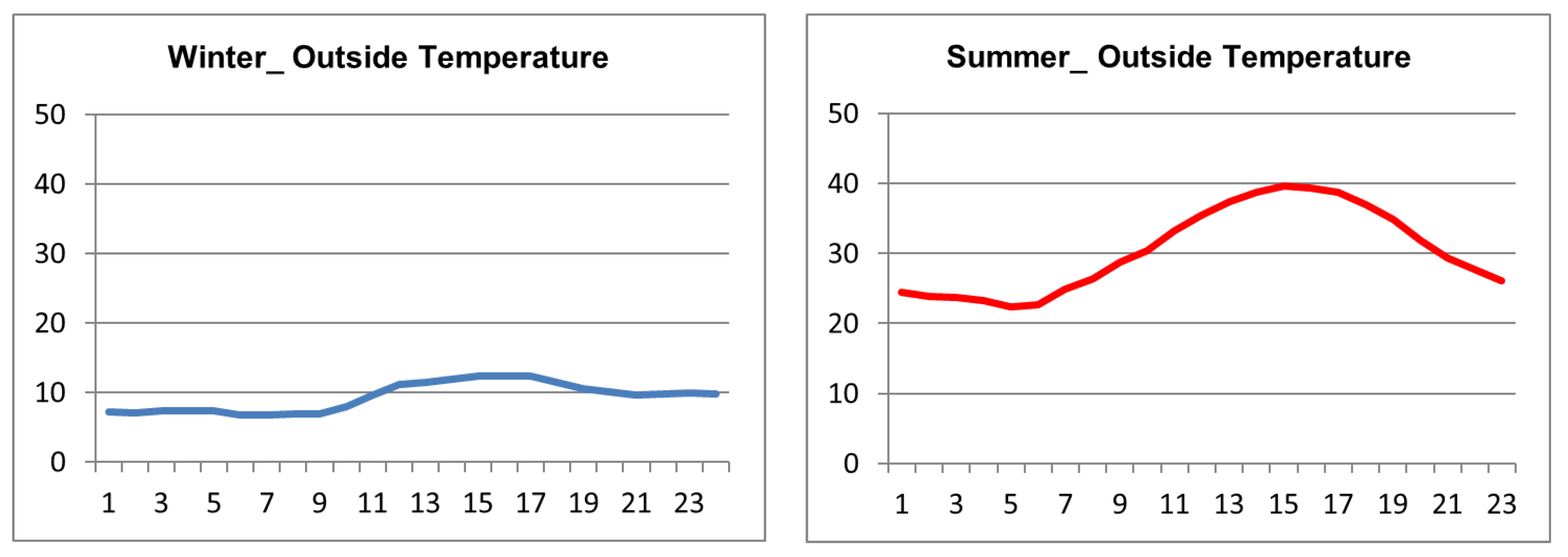
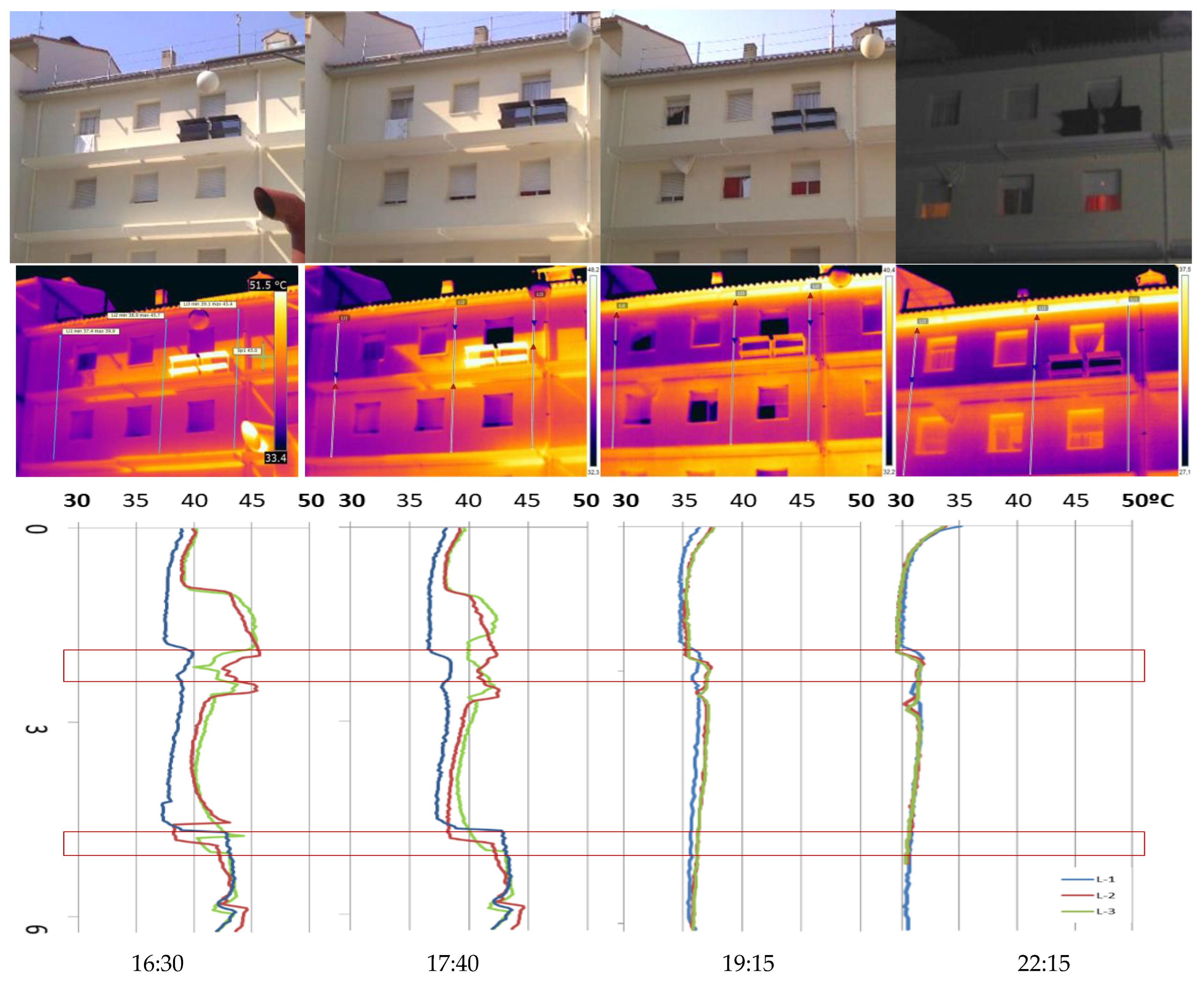

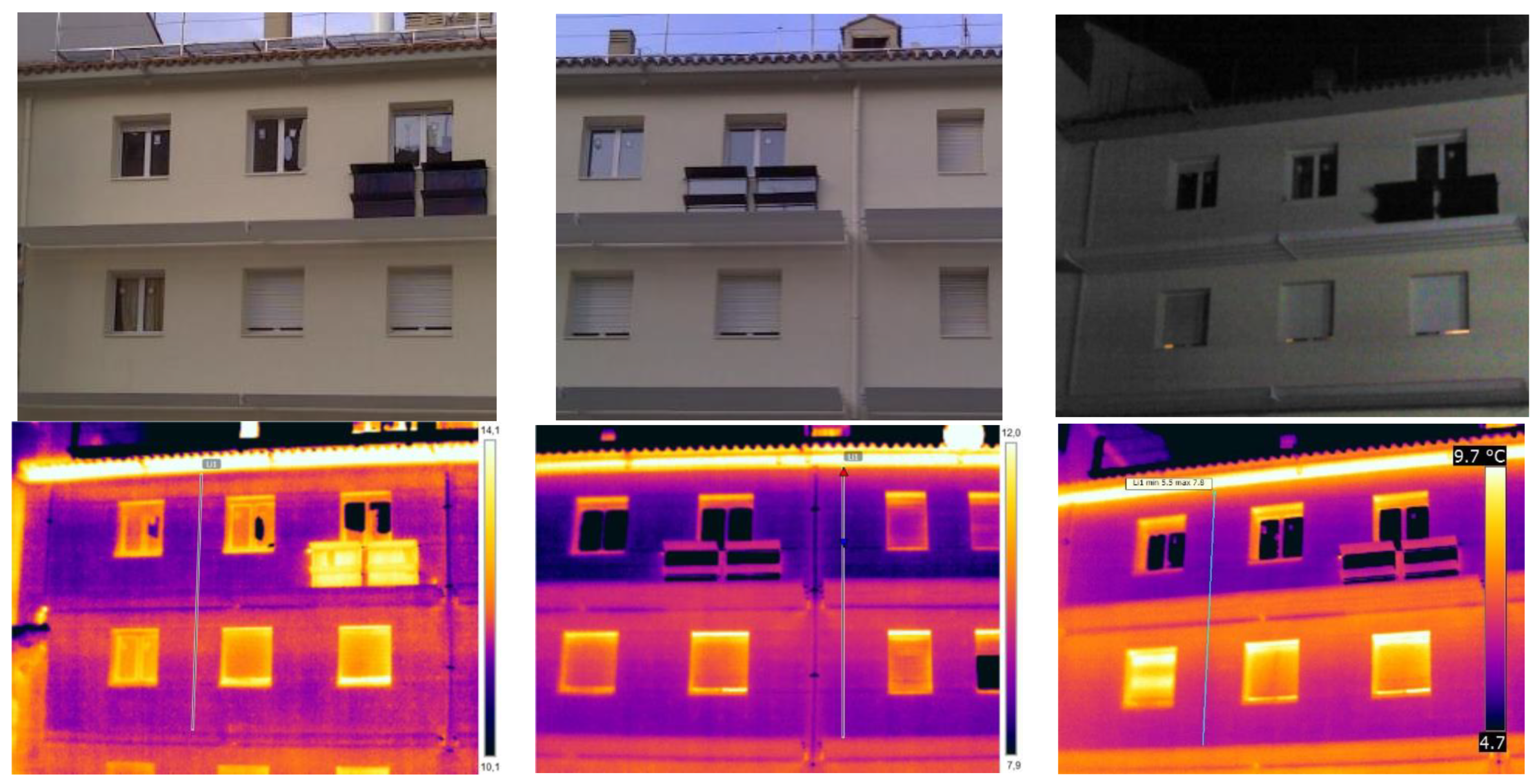


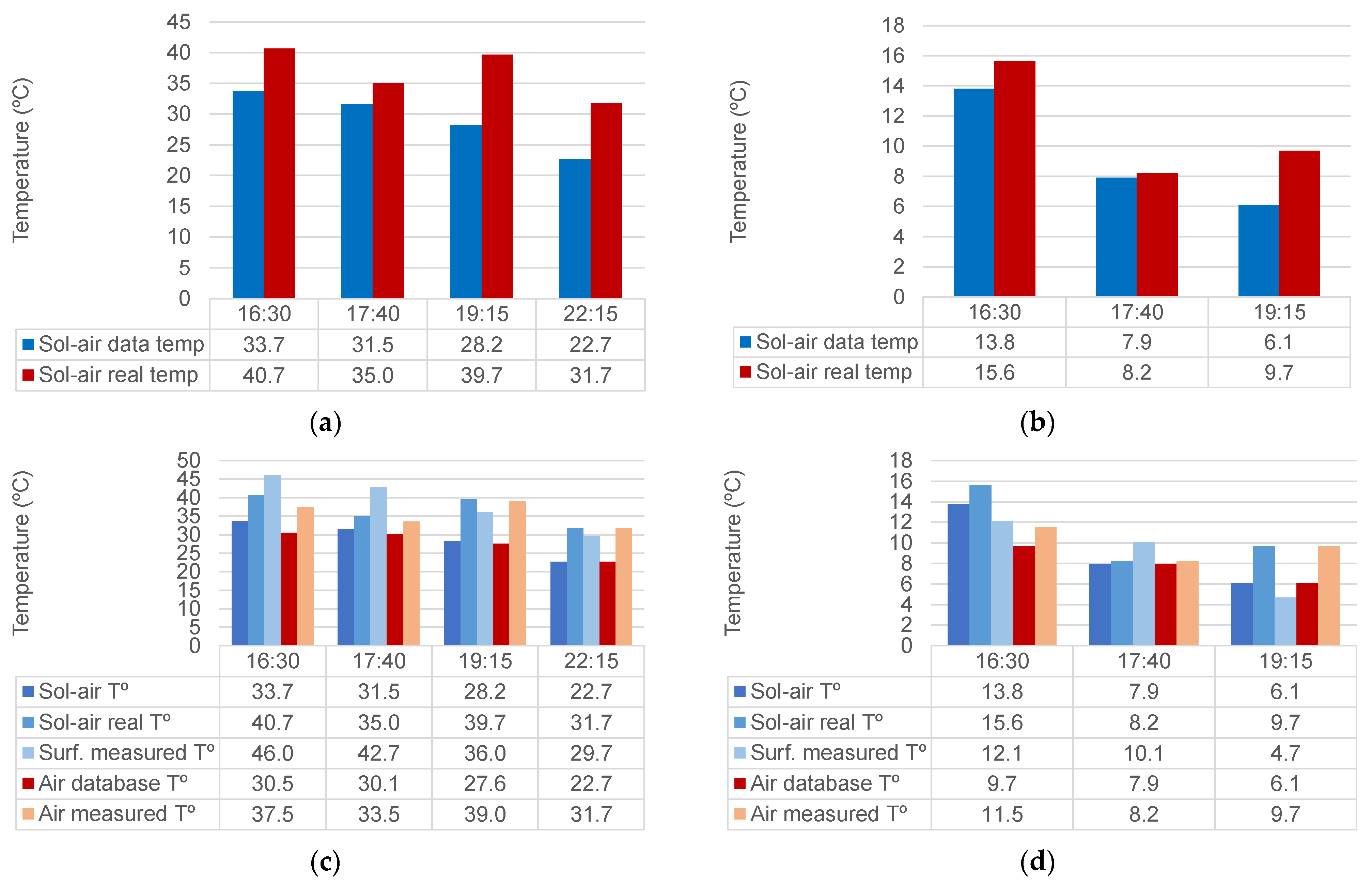
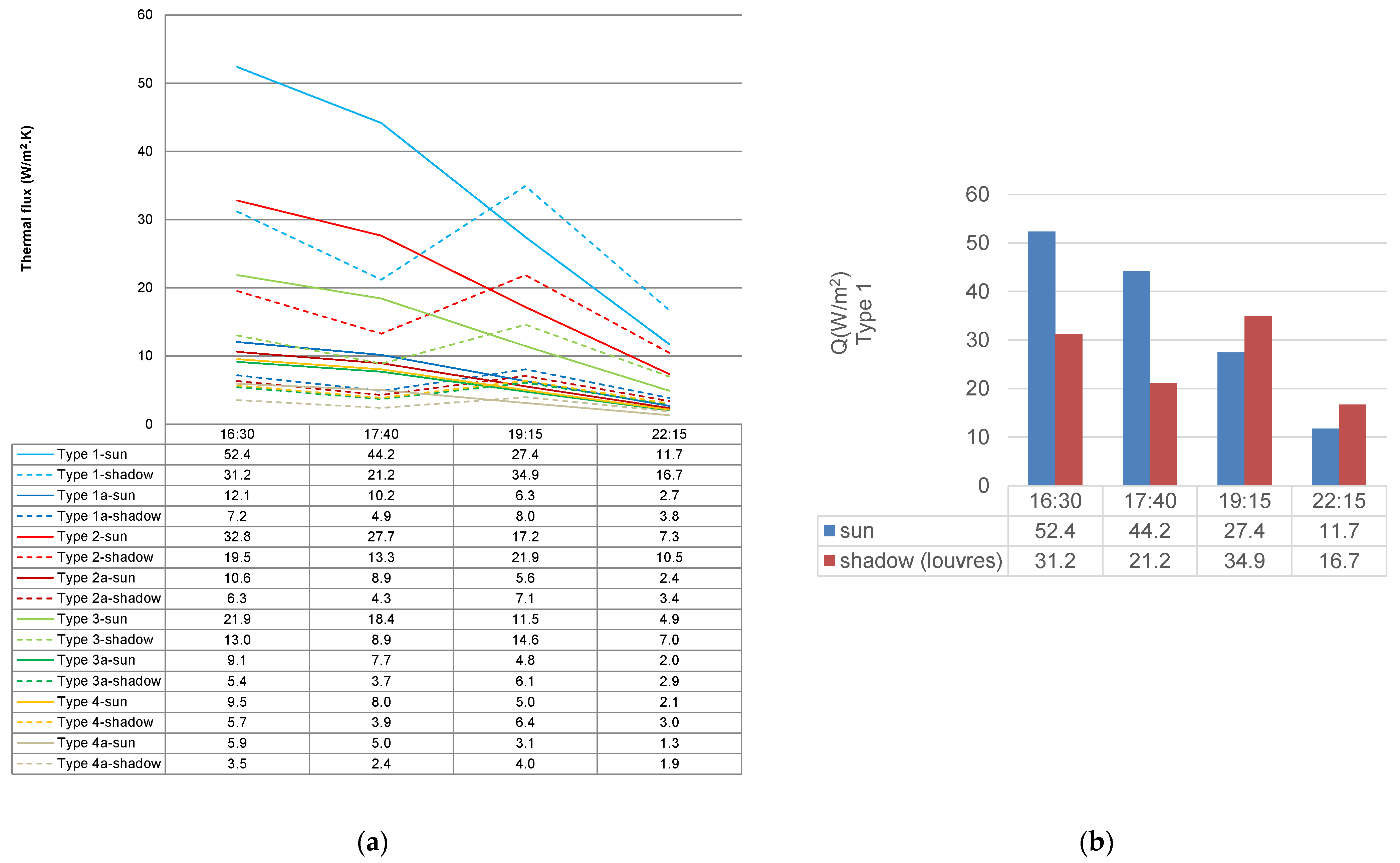
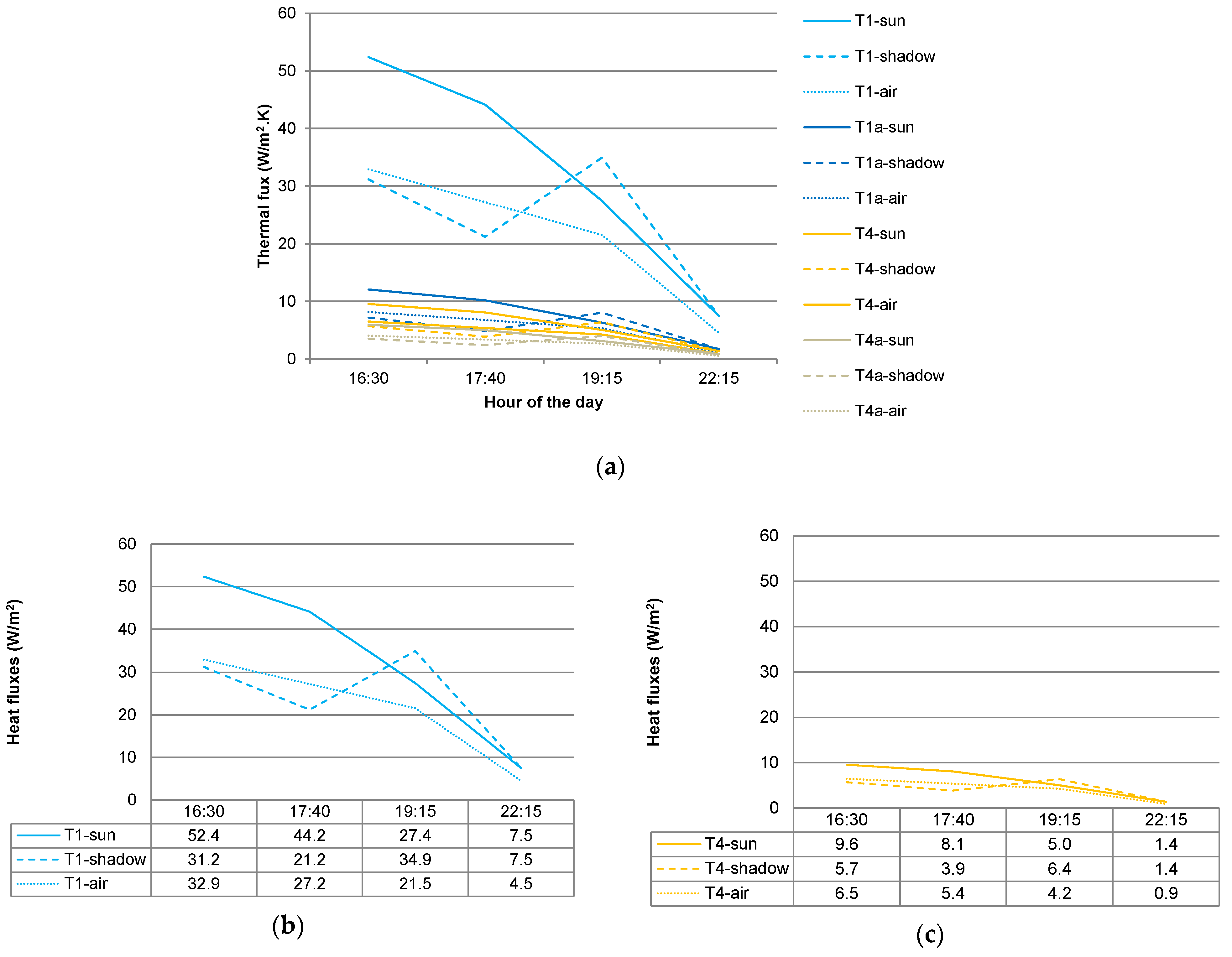
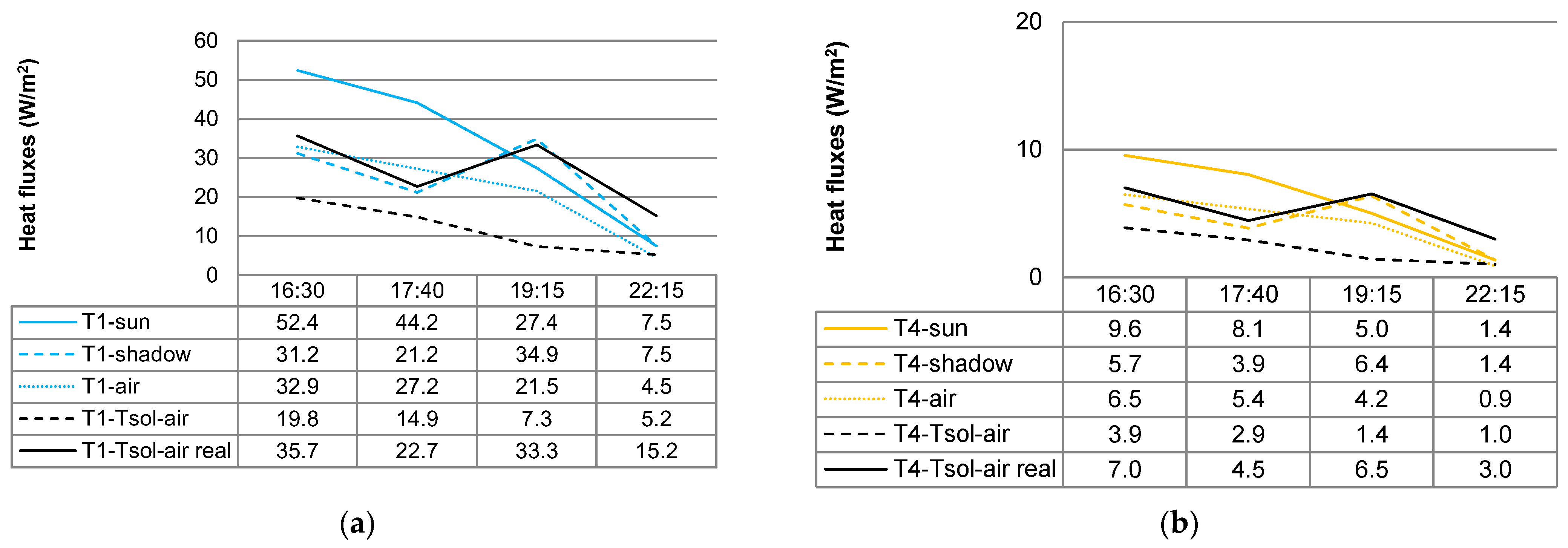
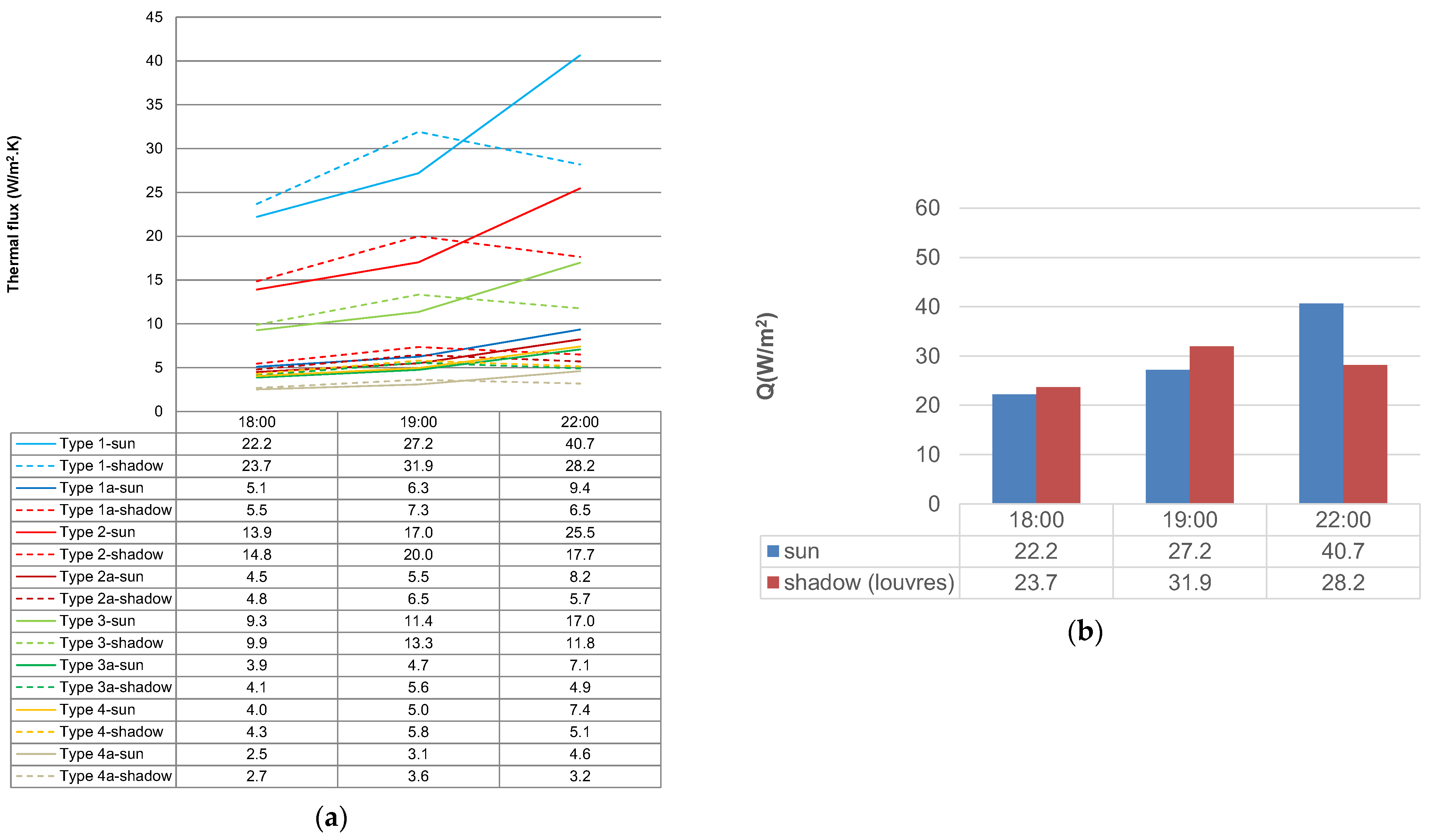
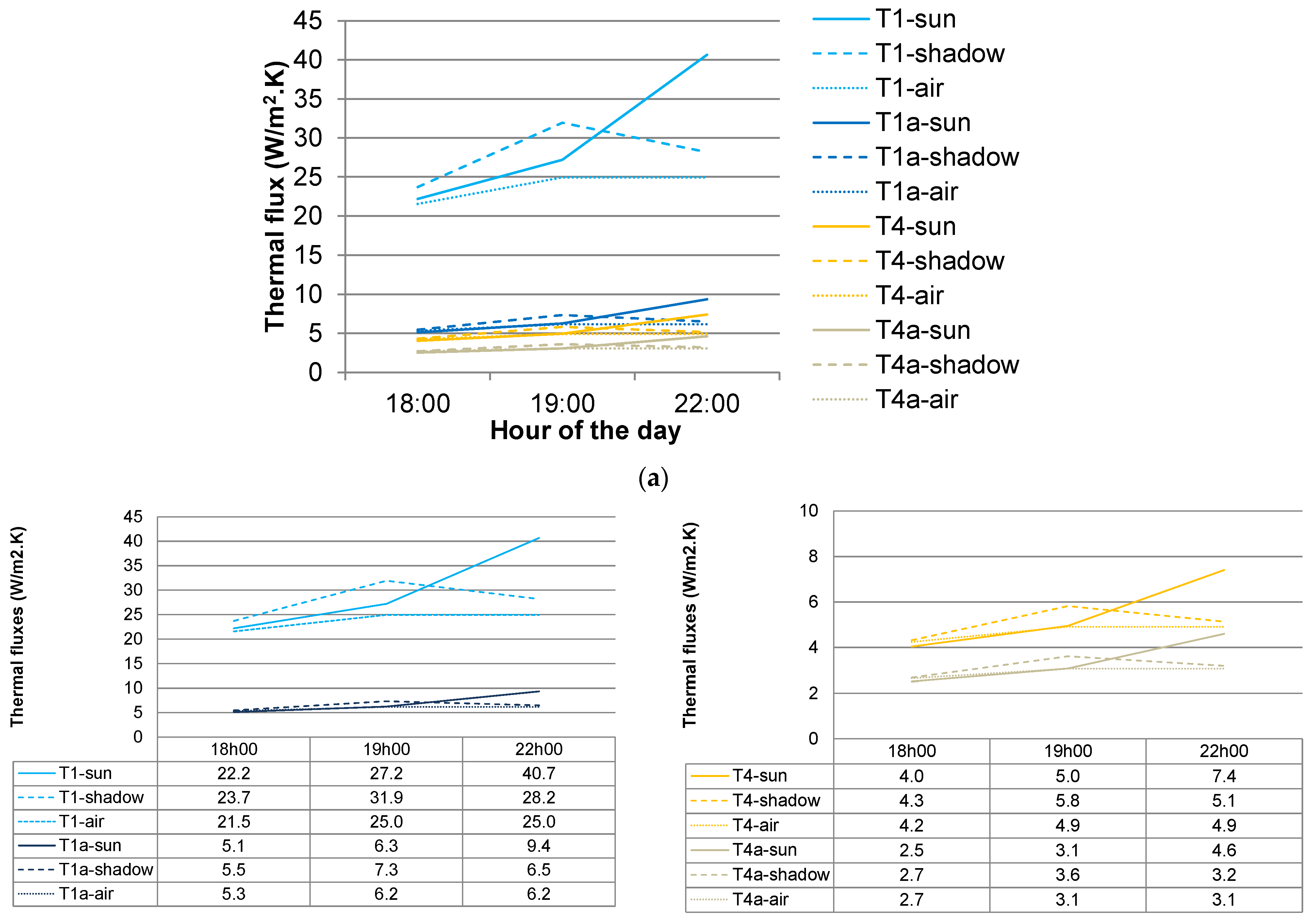
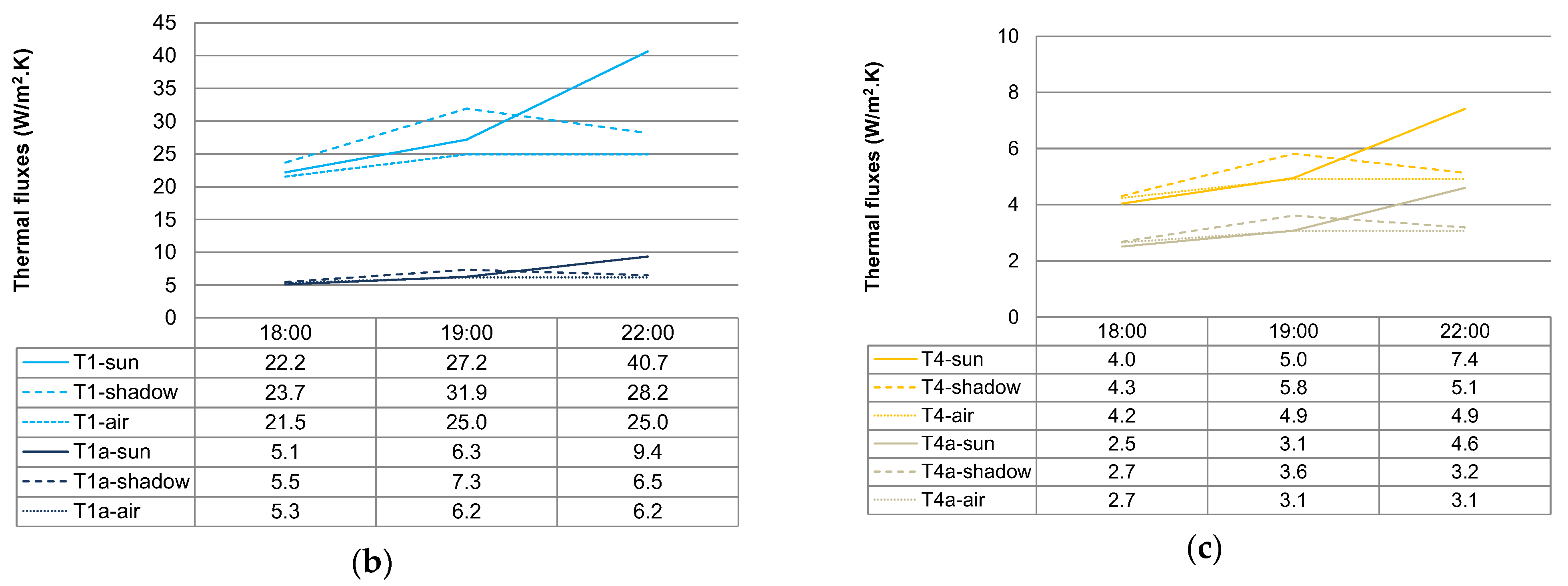

| Day | T Med (°C) | T Max (°C) | T Min (°C) | HR. Med (%) | Rain-Total (mm) | Average Visibility (Km) | Air Speed (m/s) | ΔT (°C) | Dir. Irr. 90° (kW/m2) | |
|---|---|---|---|---|---|---|---|---|---|---|
| Jan. | 26 | 6.7 | 11.4 | 4 | 62 | 0 | 11.3 | 10.92 | 7.4 | 6.24 |
| 27 | 8.7 | 14.6 | 6 | 68 | 0 | 11.3 | 12.08 | 8.6 | 5.87 | |
| 28 | 8.6 | 12.8 | 6 | 66 | 0 | 10.8 | 8.81 | 6.80 | 4.77 | |
| 29 | 11.1 | 16.7 | 5 | 62 | 0 | 10.6 | 8.17 | 11.7 | 5.71 | |
| 30 | 9.2 | 14.2 | 6 | 82 | 0.25 | 10 | 4.72 | 8.2 | 0.99 | |
| 31 | 6.4 | 10.8 | 2 | 77 | 8.38 | 9.5 | 7.14 | 8.8 | 0.37 | |
| Day | T average (°C) | T maximum (°C) | T minimum (°C) | HR. average (%) | Rain-total (mm) | Average Visibility (Km) | Air Speed (m/s) | ΔT (°C) | Dir. Irr. 90° (kW/m2) | |
| June | 27 | 26.7 | 36.6 | 20 | 44 | 0 | - | 5.36 | 16.6 | 1.32 |
| 28 | 28.7 | 39.2 | 22 | 36 | 0 | - | 4.33 | 17.2 | 1.45 | |
| 29 | 27.7 | 37.6 | 19 | 41 | 0 | - | 4.53 | 18.6 | 1.36 | |
| 30 | 29.9 | 39.6 | 22 | 35 | 0 | 10.8 | 4.89 | 17.6 | 1.51 | |
| July | 1 | 29.6 | 38.2 | 23 | 35 | 0 | 10.8 | 7.50 | 15.2 | 1.42 |
| 2 | 27.8 | 34.6 | 23 | 39 | 0 | 10.5 | 5.92 | 11.6 | 1.22 | |
| 3 | 28.7 | 36.5 | 22 | 38 | 0 | 12.6 | 7.19 | 14.5 | 1.28 |
| Name | Description | Rm + Rsi (m2.K/W) | Rse + Rm + Rsi (m2.K/W) |
|---|---|---|---|
| Type 1 | Cement render (15 mm) + solid masonry brick (240 mm) + gypsum plaster (15 mm) | 0.40 | 0.44 |
| Type 1a | Type 1 + expanded polystyrene (50 mm) + cement mortar (10 mm) | 1.74 | 1.78 |
| Type 2 | Perforated brick masonry (120 mm) + air chamber (40 mm) + hollow brick masonry (40 mm) + gypsum plaster (15 mm) | 0.64 | 0.68 |
| Type 2a | Type 2 + expanded polystyrene (50 mm) + cement mortar (10 mm) | 1.98 | 2.02 |
| Type 3 | Cement render (15 mm) + perforated brick masonry (120 mm) + mineral wool (20 mm) + hollow brick masonry (40 mm) + gypsum plaster (15 mm) | 0.96 | 1.00 |
| Type 3a | Type 3 + expanded polystyrene (50 mm) + cement mortar (10 mm) | 2.30 | 2.34 |
| Type 4 | Cement render (15 mm) + perforated brick masonry (120 mm) + mineral wool (70 mm) + hollow brick masonry (40 mm) + gypsum plaster (15 mm) | 2.20 | 2.24 |
| Type 4a | Type 4 + expanded polystyrene (50 mm) + cement mortar (10 mm) | 3.54 | 3.58 |
Disclaimer/Publisher’s Note: The statements, opinions and data contained in all publications are solely those of the individual author(s) and contributor(s) and not of MDPI and/or the editor(s). MDPI and/or the editor(s) disclaim responsibility for any injury to people or property resulting from any ideas, methods, instructions or products referred to in the content. |
© 2024 by the authors. Licensee MDPI, Basel, Switzerland. This article is an open access article distributed under the terms and conditions of the Creative Commons Attribution (CC BY) license (https://creativecommons.org/licenses/by/4.0/).
Share and Cite
Barbero-Barrera, M.d.M.; Tendero-Caballero, R.; García de Viedma-Santoro, M. Impact of Solar Shading on Façades’ Surface Temperatures under Summer and Winter Conditions by IR Thermography. Architecture 2024, 4, 221-246. https://doi.org/10.3390/architecture4020014
Barbero-Barrera MdM, Tendero-Caballero R, García de Viedma-Santoro M. Impact of Solar Shading on Façades’ Surface Temperatures under Summer and Winter Conditions by IR Thermography. Architecture. 2024; 4(2):221-246. https://doi.org/10.3390/architecture4020014
Chicago/Turabian StyleBarbero-Barrera, María del Mar, Ricardo Tendero-Caballero, and María García de Viedma-Santoro. 2024. "Impact of Solar Shading on Façades’ Surface Temperatures under Summer and Winter Conditions by IR Thermography" Architecture 4, no. 2: 221-246. https://doi.org/10.3390/architecture4020014
APA StyleBarbero-Barrera, M. d. M., Tendero-Caballero, R., & García de Viedma-Santoro, M. (2024). Impact of Solar Shading on Façades’ Surface Temperatures under Summer and Winter Conditions by IR Thermography. Architecture, 4(2), 221-246. https://doi.org/10.3390/architecture4020014






